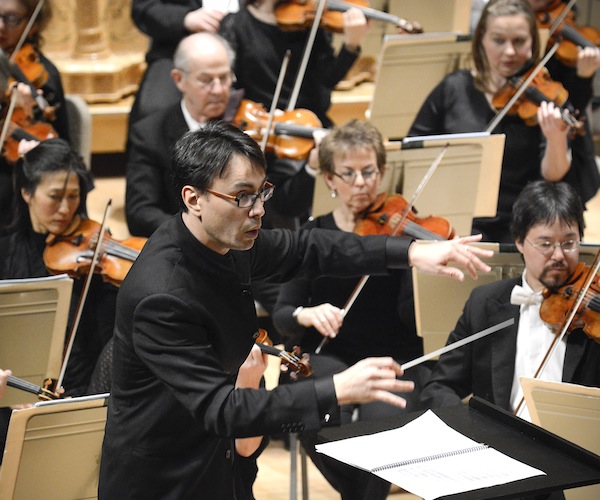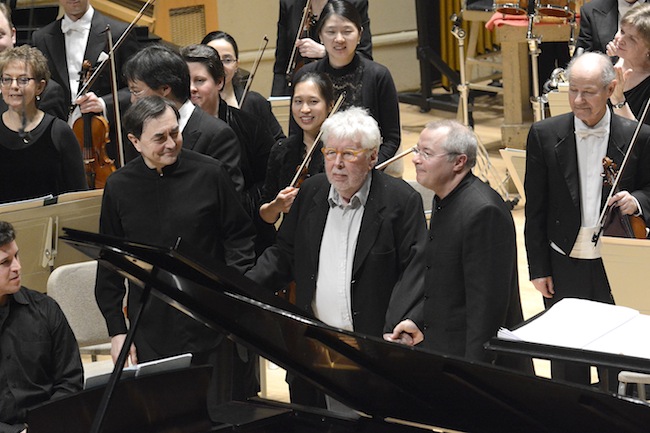Concert Review: Ken-David Masur and Stefan Asbury conduct the Boston Symphony Orchestra
After several years in the wilderness, it seems that, on the conducting front at last, the BSO is again in good hands.

Ken-David Masur leading the Boston Symphony Orchestra in the music of Debussy, Liadov, and Stravinsky on Thursday night at Symphony Hall. Photo: Stu Rosner.
By Jonathan Blumhofer
Understandably lost amid the hubbub of recent record-breaking weather was the news of the latest conductor to cancel on the Boston Symphony Orchestra (BSO). Vladimir Jurowski, the Russian maestro whose 2012 debut with the BSO turned not a few heads, withdrew on short notice due to a work visa mix-up. His agency apparently erred, or so says a program insert, so BSO audiences are sans Jurowski this Valentine’s Day weekend.
Thankfully, Jurowski’s program, one of the orchestra’s more exciting of the season, remains intact. For that we have not one, but two, conductors to thank: Stefan Asbury and Ken-David Masur, the latter the BSO’s increasingly busy assistant conductor (he filled in for an indisposed Tugan Sokhiev in January). There were four pieces on Friday’s concert, spanning a very packed hundred-and-twenty-or-so years.
The first (and oldest) was a staple, Debussy’s Prelude to the Afternoon of a Faun, sculpted with sumptuous color and loving care by Masur. Principal flute Elizabeth Rowe earned a hearty cheer for her supple accounts of her big solos, but the whole orchestra delivered a chamber-like performance of Debussy’s popular score. If Masur’s wasn’t the most impassioned account of this Prelude, it was at least a very beautiful one, warm and lush.
Harrison Birtwistle’s Responses: sweet disorder and the carefully careless is, on the other hand, anything but warm and lush. It almost goes without saying that Birtwistle’s latest score – a concerto that continuously thwarts the traditional soloist-orchestra relationship – is a tough nut to crack. Like Milton Babbitt, Elliott Carter, and Pierre Boulez, there’s nothing simple about Birtwistle’s music. Now 81, he’s crusty as ever, and unabashedly so. His musical language is knotty and often dissonant. Suffice it to say, you probably won’t head into intermission after hearing Responses humming any of its tunes.
But, if you take Birtwistle at his word, there’s much to appreciate in this score. The music functions as a kind of perpetually evolving (or developing) organism. Its primary materials are clearly set out over its opening minutes. It possesses lots of color – there are some marvelous orchestrations for strings and percussion around and after the halfway point – and, throughout, a great sense of rhythmic energy. Yes, much of the fast music is spiky, both melodically and harmonically, but it’s never really cold or austere. The passages of muted brass in its first half are downright, laugh-out-loud funny.
One can approach Responses as an intense kind of ear training game, tracking its various gestures and motives as they transform over time and are layered across and through the orchestra. That’s basically what BSO violinist James Cooke, in his introductory comments to Friday’s concert, suggested. And, perhaps, that’s the best way to hear Responses on the first time through. But it seemed to me that there is much more to the score than what meets the ear in its initial appearance (like the fearsome, discordant brass chords near the end that portend something seriously dramatic); greater rewards await repeated listening.
Of course, the shelf life of a piece like Responses is anyone’s guess. And it’s hard to say with accuracy just how well the premiere of a challenging new work was played. But, to judge from the incisive, energetic delivery of the orchestra under Asbury (making his BSO Symphony Hall debut; he’s a Tanglewood fixture who conducted the world premiere of Responses in Munich last October and was, remarkably, free on short notice) and the concentrated account of the solo part by the awesome Pierre-Laurent Aimard, this was a mightily triumphant performance. I, for one, found the piece wholly engaging both intellectually and musically. There was never the sense that it overstayed its welcome or lost track of its message at any point during its thirty-minute duration. And that – especially if you’ve heard any amount of overwrought Modernist composition – is an accomplishment worthy of praise. Birtwistle was on hand to bask in some well-deserved cheers.
I wish I could be as enthusiastic about Anatol Liadov’s From the Apocalypse. At the very least, this 1912 score is a waste of a promising title. At the worst, it’s a turgid, forgettable entry into the bloated canon of symphonic poems (or, more accurately in this case, symphonic tableaus).
Liadov took as his inspiration a passage from the tenth chapter of the Book of Revelation, describing the descent of the Angel with the Little Scroll. And, if you follow the text while listening to the piece, you may find Liadov’s painting of its various sections impressive. My personal favorite was the closing depiction of seven thunders played by solo timpani. But if you’re looking for a symphonic essay in the tradition of Don Juan or even Danse macabre, one that leaps off the page, exceeds the narrative suggested by its title, and redefines your understanding of its program, you’re probably going to come away disappointed. Liadov’s writing unfolds like a series of disconnected vignettes and is, in musico-dramatic terms, far too inert to ever realize the wonder, terror, and mystery of the text it is meant to describe.

Pierre-Laurent Aimard, Harrison Birtwistle, and Stefan Asbury bow following the BSO’s American premiere performance of Birtwistle’s “Responses.” Photo: Stu Rosner.
Jurowski might have made more out of the piece than did Masur; then again, maybe not. The BSO brass played marvelously, the strings shimmered, and the percussion battered away before fading to nothingness. But it didn’t really add up to much.
The BSO’s run-through of the 1919 version of Stravinsky’s Firebird Suite was another story. Friday’s performance didn’t pack the punch of Esa-Pekka Salonen’s knockout reading of the complete ballet in 2012, but it did have its spine-tingling moments. Masur led an interpretation that emphasized Stravinsky’s debt to Ravel and Debussy – the delicate woodwinds in the “Variations of the Firebird” and the Round Dance were articulated with pristine tone – but didn’t shy away from the music’s folksy, rhythmic drive. There were a couple of choppy entrances (among other things, a trombone anticipated the downbeat of the “Infernal Dance”) but, on the whole, this was a pulsing, exciting account of a well-worn masterpiece.
It may not be a first, but it certainly must be rare that an orchestra’s music director is younger than its assistant conductor (Andris Nelsons is 36; Masur, 37). On the podium, both exhibit similar mannerisms: Masur is a bit more balletic while Nelsons tends to lunge. But the BSO responds to both with warmth, energy, and enthusiasm. After several years in the wilderness, it seems that, on the conducting front at last, the BSO is again in good hands.
Jonathan Blumhofer is a composer and violist who has been active in the greater Boston area since 2004. His music has received numerous awards and been performed by various ensembles, including the American Composers Orchestra, Kiev Philharmonic, Camerata Chicago, Xanthos Ensemble, and Juventas New Music Group. Since receiving his doctorate from Boston University in 2010, Jon has taught at Clark University, Worcester Polytechnic Institute, and online for the University of Phoenix, in addition to writing music criticism for the Worcester Telegram & Gazette.
Tagged: Boston Symphony Orchestra, Harrison Birtwistle, Ken-David Masur, Responses
